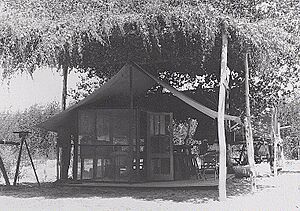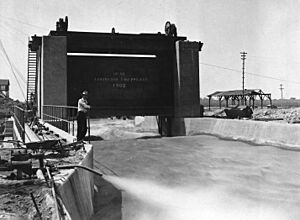Yuma Project facts for kids
The Yuma Project is a big construction project by the U.S. Bureau of Reclamation. It was built to bring water to over 68,000 acres (275 square kilometers) of farmland. This land is in Yuma County, Arizona and parts of Imperial County, California. The project helps farmers grow crops all year long by using water from the Colorado River.
The Yuma Project includes the Laguna Diversion Dam, special pumps, a power plant, and a huge system of canals. There are 53 miles (85 kilometers) of main canals and 218 miles (351 kilometers) of smaller canals. It also has walls (levees) to stop floods and drains to remove extra water. Construction started in 1903, and most of it was finished by 1915. This was the very first dam and water project on the Colorado River. Workers faced many challenges to build and keep it running. The Laguna Diversion Dam was later replaced by the Imperial Dam as the main water source between 1941 and 1948. Today, the Yuma Project helps 275 farms and more than 94,000 people.
Contents
Why Was the Yuma Project Needed?
Even though southern Arizona and California are very hot, they have a long farming season. The Colorado River also flows through this area. The Bureau of Reclamation and the Yuma County Water Users' Association wanted to use these conditions. Their goal was to create a huge area where farming could happen with water from the river.
The project was divided into two main parts. The Valley Division was in Yuma County, Arizona. The Reservation Division was in Imperial County, California. The Reservation Division also had smaller sections called the Bard Unit and the Indian Unit. Much of the land for the Reservation Division used to be part of the Fort Yuma Indian Reservation.
How the Yuma Project Was Built
In 1854, the United States bought the land for the Yuma Project in the Gadsden Purchase. Later, in 1884, the Fort Yuma Indian Reservation was created for the local Quechuan people. There were arguments over the land in the 1890s. In 1910, a law called the Dawes Severalty Act opened the land to new settlers. This caused even more disagreements. After several court cases, the United States officially owned the land by 1898.
Farmers in the area tried to build their own simple irrigation systems. But these systems did not work very well. In 1902, the Reclamation Act was passed. This law set aside money for farm development in the western U.S. It also created the U.S. Bureau of Reclamation. In 1903, President Theodore Roosevelt gave the entire Fort Yuma Indian Reservation to the Bureau of Reclamation for development. Farmers then formed the Yuma County Water Users' Association in 1903. In 1904, the U.S. Secretary of the Interior, Ethan A. Hitchcock, officially approved the Yuma Project.
Building the Laguna Dam
The Bureau of Reclamation, with engineer Francis L. Sellew, quickly started buying the land needed. They began the project by building the Laguna Diversion Dam on the Colorado River. On July 6, 1905, a company called J. G. White and Company won the contract to build the dam. They started construction less than two weeks later.
Getting materials like cement was a big problem. Cement had to come by train to Yuma. Then, it was moved to the construction site by wagons or steamboat. The local rocks were also not very good quality. About half of the weak rock could not be used. These problems caused many delays. J. G. White and Company missed their deadline, so the Bureau of Reclamation took over building the dam in early 1907.
To fix the cement problem, the Bureau of Reclamation built a wall (levee) on the California side of the dam by March 1908. A rail line was built on top of this levee. They also worked with the Southern Pacific Railroad. The railroad agreed to deliver cement directly to the dam site. The rock quality problem was solved by building up the walls (cofferdams) with rock waste. Rail lines on top of these walls helped deliver rock-fill much faster.
By December 1908, a way for water to go around the dam was finished. Workers then started pouring the rock-fill. Three large concrete walls were built across the river for the dam's base. Rock-fill was placed between and around these walls for support. The California side of the dam had three iron gates to control water flow. The Arizona side had one gate. Most of the workers on the dam were Mexican-American, and some were Native American Indians. White workers mostly worked during the cooler months.
Creating the Canals
Work on the Yuma Canal started in 1909. This canal branched off from the California side of the Laguna Dam. About 1.5 miles (2.4 kilometers) from the dam, the Yuma Canal splits into two smaller canals: the Reservation Main Canal and the Yuma Main Canal.
The Yuma Main Canal goes southwest for 10.5 miles (16.9 kilometers). It reaches a place called the Siphon Drop Spillway. A power plant was built there later in 1926. After another 3.5 miles (5.6 kilometers), the canal reaches the Colorado River Siphon. This special tunnel carries water under the Colorado River. After crossing under the river, the canal reaches Yuma. It then splits into the East and West Main canals. These canals carry water through the Valley Division and down to the Mexican border. The Yuma Main Canal and parts of the East and West Main Canals were finished by 1912. The rest of the West Main Canal was completed in 1915.
Work on the Reservation Main Canal began in 1907. Smaller canals branching off it started in 1908. The Mojave and Cocopah Canals were built as branches of the Reservation Canal. Construction on the Colorado River Siphon began in 1909. It was designed to move water from the Yuma Main Canal to the Valley Division. Work on the siphon stopped in February 1911 because the surrounding rock was too soft and unstable. The Bureau of Reclamation decided to use compressed air to finish it. This allowed the siphon to be built deeper, at 76 feet (23 meters). It started working on June 29, 1912. In total, the Yuma Project has 53 miles (85 kilometers) of main canals and 218 miles (351 kilometers) of smaller canals.
Building Drains and Levees
A system of drains and some wells were built throughout the project. They help remove extra water and runoff from the irrigated farms. The drains in the Reservation Division send water directly into the Colorado River. About half of these drains are meant to catch leaks from the nearby All-American Canal. In the Valley Divisions, the drains run through the middle, and wells are in the east. All the drained water is removed at the Boundary Pumping Station, which started in 1919.
Walls called levees were also built between 1907 and 1909. These levees protect the banks of the Colorado River from flooding. They also stop the river from changing its course. The Reservation levee was built on the west bank of the river. The Yuma Valley levees were on the east bank, going down to the Mexican border. To keep the levees strong, the Bureau of Reclamation built rail lines on top of the Reservation levee. This allowed rail cars to bring materials to fix problem areas. This worked well during a big flood in 1912. The Bureau also built the Yuma Valley Railway in 1914 to help maintain those levees. It was finished in February 1915.
Changes and Maintenance
Flooding continued to be a problem for the Yuma Project. In January 1916, a flood caused 800 feet (244 meters) of breaks in the Reservation Levee. The river flooded again a few days later. These floods covered large parts of the Reservation and Valley Divisions. They also moved 50,000 yards (45,720 meters) of the main canal. The Bureau of Reclamation worked very fast to fix everything in just 15 days. In 1918, the Colorado River's changing path damaged part of the Reservation levee. It was repaired slowly because many workers were fighting in World War I.
An earthquake on May 18, 1940, caused a lot of damage to the Project, especially in the Valley Division. Canals, levees, and other parts were damaged but were repaired by the end of May. From 1936 through World War II, workers from the Civilian Conservation Corps, Native Americans from Mexico, and even Italian and German prisoners helped maintain the project.
A new law in 1928, the Boulder Canyon Project Act, brought big changes. This law allowed the building of the Hoover Dam, which helped control flooding on the Colorado River. It also approved the All-American Canal and the Imperial Dam. The Imperial Dam was built to be the main dam for diverting water in the lower Colorado River. It would also supply water to the Yuma Project. The Imperial Dam was finished in 1938. In 1941, the Bureau of Reclamation stopped sending water from the Laguna Diversion Dam to the Yuma Main Canal. By June 23, 1948, all water for the Yuma Project came from the Imperial Dam. Because it was no longer needed, the power plant at the Siphon Drop Spillway was shut down in 1972.
How the Yuma Project Helps Today
The Yuma Project provides water to 275 farms and more than 94,000 people. In 1992, the project irrigated 58,626 acres (237 square kilometers) of land. The crops grown on this land were worth over $196 million. The Reservation Division receives about 123 cubic feet (3.5 cubic meters) of water per second. The Valley Division receives about 937 cubic feet (26.5 cubic meters) of water per second.




